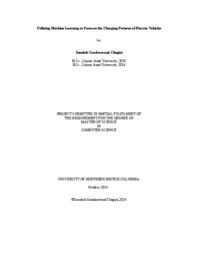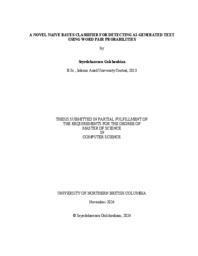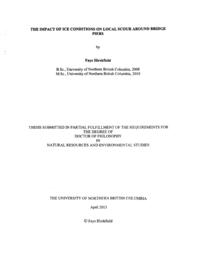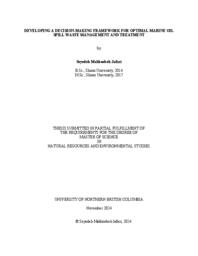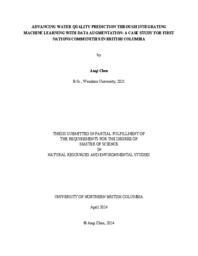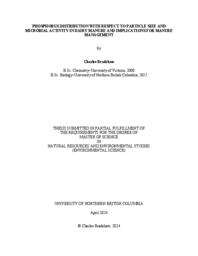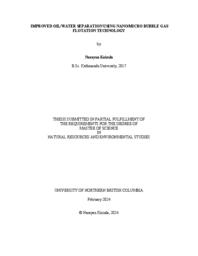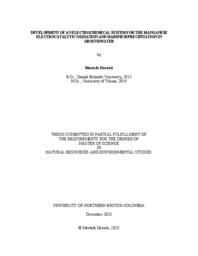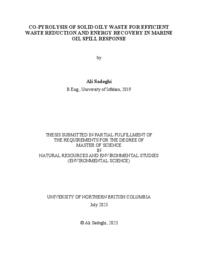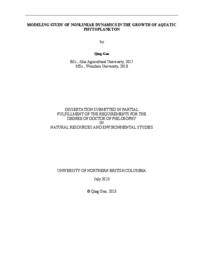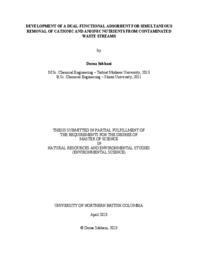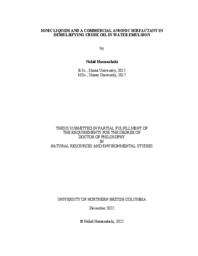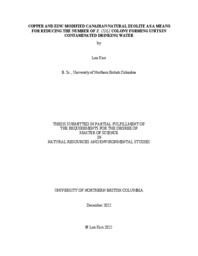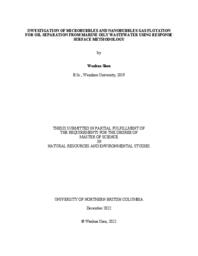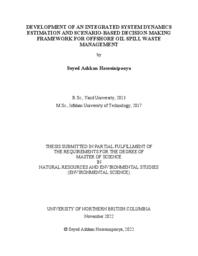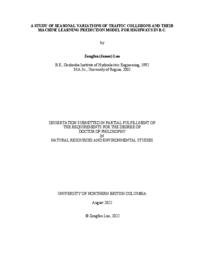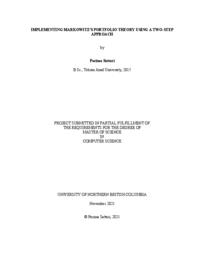Li, Jianbing
Person Preferred Name
Jianbing Li
Related Works
Content type
Digital Document
Description / Synopsis
The motivation behind this thesis arises from the high labor costs commonly
observed in Canadian communities, where residents are often forced to acquire multiple skills to cope with everyday needs. A web-based skill-exchange platform—where
two people trade services using their respective skills—would be valuable. However,
population sparsity often makes matching difficult. To address this challenge, we explore a novel approach to the sharing economy: a local mutual-aid platform. Within
this platform, users can consume services provided by others through virtual tokens,
while the only way to earn tokens is by offering services themselves. Since these tokens are purely virtual, mutual-aid activities do not incur legal liabilities, nor do
they risk creating full-time workers motivated solely by financial profit, which could
undermine the spirit of reciprocity.
On the implementation side, this thesis leverages an optimized Retrieval-Augmented
Generation (RAG) approach to enable query handling under sparse data conditions,
ensuring that even limited datasets can yield accurate and explainable recommendations. Furthermore, a self-developed distributed transaction manager based on
the Saga pattern ensures the integrity of user data across distributed environments,
supporting consistent balance updates, order confirmations, and notifications.
The prototype platform we developed demonstrates how combining modern AI
techniques with lightweight distributed systems can provide both practical utility
and long-term sustainability for local help ecosystems.
Origin Information
Content type
Digital Document
Origin Information
Content type
Digital Document
Origin Information
Content type
Digital Document
Origin Information
Content type
Digital Document
Origin Information
Content type
Digital Document
Origin Information
Content type
Digital Document
Origin Information
Content type
Digital Document
Origin Information
Content type
Digital Document
Origin Information
Content type
Digital Document
Description / Synopsis
This research explores estimating off-shore oily waste, considering waste-waste compatibility due to the heterogeneous nature of oily waste. Firstly, hyperparameters for Artificial Neural Networks (ANN), Support Vector Regression (SVR), and Improved Random Forest (IRF) models are optimized to develop a comprehensive oily waste estimation model incorporating liquid, solid, and total waste types. The results show that IRF is the most accurate model, with the lowest error indices and a higher correlation coefficient compared to ANN and SVR. This study then takes a step further to propose a waste allocation framework, which is tested using information on the Bella Bella oil spill incident in British Columbia. Incorporating treatment and receiving facilities' details, such as their location and capacity, the framework distinguishes all possible waste pathways for handling the waste from source to landfill. Genetic Algorithm (GA) is introduced to optimize waste transfer processes and successfully minimize transportation costs. The results show that the model can find the most optimized path to reduce transportation costs. The model's high customization, adaptability, and capacity to consider multiple nodes make it suitable for complex waste transfer networks, demonstrating its practicality in emergency situations. Efficiently allocating resources and ensuring cost-effective waste transportation while considering facility capacities and waste compatibility, the study holds practical implications for waste management practitioners, environmental authorities, and response teams.
Origin Information
Content type
Digital Document
Description / Synopsis
Clean drinking water access is essential for public health and regarded as a scarce resource for Indigenous communities in rural and remote areas. In this research, a new iron and manganese prediction method based on Data Augmentation and Machine Learning Algorithms to be applied to drinking water in BC’s First Nation communities is reported. GAN based modelling and NIBS-NI based modelling were developed to investigate the effects of different data augmentation methods and predictors for iron and manganese prediction results. Reliable synthetic data was obtained through both data augmentation methods, allowing 4 machine learning algorithms to predict iron and manganese utilizing 3 and 5 physical properties respectively. Compared with RF, XGB, and DT machine learning models, the GBR model showed the strongest fitting ability and accurate predictions for both NI-BS-NI based modelling and GAN based modelling in predicting iron and manganese, with the Train R2 and Test R2 of two models nearing 1, and all the RMSE scores are below 0.06. The decision-making tool developed using GAN technology is considered to have greater application potential due to its ability to provide accurate predictions while requiring only 3 input physical parameters.
Origin Information
Content type
Digital Document
Description / Synopsis
This work investigated the distribution of phosphorus in dairy manure as it relates to particle size and provides experimentally derived insights for improving the management of phosphorus. The data presented here illustrates some aspects of manure handling that may be optimized for controlling the distribution of phosphorus. It provides experimental data that supplements existing literature by 1) extending the limits of study regarding particle size distribution; 2) extending the limit of centrifugal forces studied; 3) demonstrating an improved pathway for phosphorus management in wastewater using a substrate mediated flocculation process; and 4) providing some experimental observations showing that the microbiota present in dairy manure can diminish stratification of suspended solids and phosphorus concentrations within separated liquid manure products. Further, based on quadratic modeling of phosphorus relative to sieve size, and the observations that accompanied progressive washing and mechanical agitation performed, a convincing argument for relating phosphorus distribution to the surface area of a substrate is made. The findings imply that much of the phosphorus present in manure is superficially bound to larger particulates, rather than an intrinsic or chemical part of the bulk material itself, and can be mediated by washing or mechanical means where the phosphorus present in coarser fractions can be shunted towards finer or liquid fractions. Approximately 80% of phosphorus was associated with particulates bound to larger substrate. Indeed, 95.5% of the phosphorus in the bulk manure was removable as particulates with cross sectional diameter less than 2mm by simple washing. Further removal of phosphorus in >2mm substrate through fermentation and leaching was also demonstrated. Some portion of this distribution in phosphorus appears to be dominated by microbes.
Origin Information
Content type
Digital Document
Description / Synopsis
This research focuses on developing environmentally friendly, biodegradable foams as alternatives to traditional petroleum-based materials like polyurethane and expanded polystyrene (EPS). Utilizing pulp and lignin through a cost-effective method, the study optimized factors such as sodium dodecyl sulfate (SDS) concentration, lignin content, and foaming time to achieve desirable mechanical properties and porosity. The box-behnken design identified optimal samples with varied characteristics, including densities from 0.013 g/cm³ to 0.077 g/cm³ and porosities from 95.2% to 99.2%. The introduction of lignin improved foam strength, with compression pressures ranging from 37.5 to 379 kPa. Additionally, the impact of chitosan on porosity, strength, and water resistance was examined. Incorporating 20 wt.% of chitosan enhanced strength by 4% and reduced water absorption by 60%. Over three months, the biodegradable foams displayed significant degradation, introducing them as sustainable alternatives to EPS for diverse applications like packaging.
Origin Information
Content type
Digital Document
Description / Synopsis
This research investigated the performance of nanobubble and microbubble (NB/MB) gas flotation technology in treating oily wastewater generated after oil spill response operations. The study comprised three distinct sets of experiments. In the initial set of experiments, experiments were conducted to examine the impact of reactor configuration on the NB/MB gas flotation process. Three different reactor configurations were employed, varying in height-to-diameter ratios of 10, 20, and 30. The results indicated that reactor configuration slightly affected system performance, with gradual improvement observed as the height-to-diameter ratio increased. Following the analysis of reactor configuration, response surface methodology (RSM) was utilized to design experiments focusing on three key factors: initial oil concentration, gravity settling time and flotation time. The purpose was to analyze their impacts on oil/water separation performance and the interactions among these factors. Additionally, introducing gravity separation prior to NB/MB gas flotation aimed to assess whether allowing collected oily wastewater to settle in containers on barges would accelerate oil/water separation compared to exclusively relying on NB/MB gas flotation without gravity settling. The results from the experiment demonstrated a strong agreement between the predicted and experimental data for oil/water separation efficiency, as indicated by a high R2 value of 0.99 and an adjusted R2 value of 0.98. The predicted R² value was 0.91. Subsequently, additional single-factor experiments were conducted to determine the maximum oil/water separation efficiency. The findings revealed that an oil/water separation efficiency of 98.8% was achieved under the optimum experimental condition with the initial oil concentration of 1995 mg/L, the gravity settling time of 45 minutes and the flotation time of 38 minutes. Likewise, a second set of separate experiments was conducted after the RSM experiments to study how different levels of oil weathering affect the oil/water separation efficiency using MB and NB gas flotation. The results indicated no significant difference in oil separation efficiency between fresh and weathered oil samples. Furthermore, a third set of experiments was carried out at a pilot scale to scale up the technology and assess its feasibility. The experiments were conducted at a pilot scale (75 L). The results demonstrated a remarkable oil/water separation efficiency of 92% within one hour, surpassing gravity separation, which achieved only 4.62% over the same duration. Similarly, combining NB/MB gas flotation with adsorption achieved nearly 100% oil/water separation efficiency. Thus, the result from the experiment concludes that NB/MB gas flotation is efficient in separating oily wastewater generated after oil spills. The successful implementation of NB/MB gas flotation technology in offshore oil spill response vessels offers a promising solution with exceptional separation performance and scalability, with a minimal environmental impact, as it is a chemical-free technology.
Origin Information
Content type
Digital Document
Description / Synopsis
Manganese is one of the most occurring heavy metals in the source and drinking water of rural and remote communities in Canada. The removal of manganese from groundwater was explored by designing a biochar-assisted electrochemical technology as a small-scale and chemical-free method. Electrocatalytic oxidation of manganese was acquired while utilizing wood residue biochar as a coating layer on the surface of activated carbon felt anode. The biochar-coated anode showed enhanced conductivity and surface area, consequently facilitating the electron exchange and manganese removal efficiency. Manganese initial concentration, current intensity, pH, and time were considered the main variables and their effect on the removal efficiency of manganese from groundwater was investigated. Current had the most influence on removal efficiency, as evidenced by the fact that no manganese removal occurred at zero current and the removal efficiency was increased by enhancing current from 25 to 75 mA. With the Mn initial concentration of 2 mg/L, current of 75 mA, pH 9, 97.5 % manganese removal efficiency was acquired, which helped to reduce the contaminant concentration under the maximum acceptable concentration. The results demonstrated a well-fitted pseudo-first-order model with a rate constant of 0.0411 min-1 for electrocatalytic oxidation. Real groundwater of Lheidli T'enneh community in Northern BC was employed to evaluate the impacts of co-existing ions on the manganese removal performance. The results confirmed that not only did the use of real groundwater have no detrimental impact on the system’s efficiency, but also the system was able to decrease the high hardness of 268.2 mg CaCO3/L in the groundwater to 72.2 mg CaCO3/L suitable for drinking purposes. Investigation of the manganese removal mechanisms indicated that various species, such as hydroxide ions, sulfate, and hydroxide radicals can play key roles in transferring or removing manganese from groundwater by oxidation and precipitation pathways. The formation of a black powder precipitated on the anode surface and in the cell after treatment proved that oxidation of manganese takes place in the system. Furthermore, the evolution of pH after 90 minutes of reaction further confirmed the presence of hydroxide ions in the system. Overall, the designed system achieved a significant performance in removing manganese and hardness from groundwater while utilizing biochar as a waste and cost-effective material.
Origin Information
Content type
Digital Document
Description / Synopsis
Despite substantial advances in cleaning up marine spills, solid oily waste generation during a spill is an inevitable problem that could easily exceed the capacity of locally available waste management facilities. This thesis developed a pyrolysis system to cope with multiple oily solid waste streams simultaneously. The treatment of contaminated sorbent through co-pyrolysis with Personal Protective Equipment (PPE) that are two types of solid oily waste in marine oil spill response was carried out in a heating mantle system over temperature and heating rate ranges of 350 to 550 °C and 5 to 20 °C/min, respectively. Response surface method was applied to evaluate the main and interaction effects of three experimental factors (contaminated sorbent ratio in feedstock, heating rate, and temperature) on pyrolysis oil and gas yields. It was found that gas yield decreased while the oil yield increased with raising the contaminated sorbent percentage in feedstock. Total weight loss as high as 99.6% (liquid; 96.8%, gas; 2.8%, and char; 0.4%) and 84.4% (liquid; 77.4%, gas; 7.0%, and char; 15.6%) was achieved at the contaminated sorbent ratios of 100% and 80%, respectively. The oil yield value of 98.1% under optimal experimental conditions (temperature; 460 °C, heating rate; 5 °C /min, and contaminated sorbent ratio; 99%) with 1% error compared to the predicted value of 97.1% validated the model. The oil obtained through co-pyrolysis at a contaminated sorbent ratio of 75% exhibited a Higher Heating Value (HHV) of 43.67 MJ/Kg, thereby suggesting its potential as an energy source. As a result, multiple types of solid oily waste can be treated through the co-pyrolysis process to produce energy-rich products, reduce the amount of waste, recover spilled hydrocarbons, and improve energy recovery.
Origin Information
Content type
Digital Document
Description / Synopsis
Phytoplankton bloom has become a growing global concern in recent years due to the excessive growth of algae, causing significant negative impacts on aquatic ecosystem and threatening human health. Growing evidence suggests that algal blooms are a consequence of the interplay of various hydrodynamical, chemical, and biological processes in aquatic systems. The complexity and nonlinearity of aquatic ecosystems, and the complexity of climatic and hydrographic events, make interpreting and predicting the blooms a very challenging task. In recent years, many different strategies have been adopted to manage algal blooms. Among them, mathematical models are advantageous because they can capture the ubiquitous stoichiometric constraints for modeling species growth and interaction. Thus, mathematical models have been widely used to investigate the dynamics of phytoplankton growth. In this study, five mathematical models were developed based on population dynamics, ecological dynamics, dynamic modeling, and probability theory. The models were investigated theoretically and numerically in terms of the theory of partial differential equations, stochastic differential equations, impulsive differential equations, and numerical simulation. The objective of this dissertation research was to gain insight into plankton dynamics and explore potential management strategies for excessive algal growth in aquatic systems. The main results are presented as follows: Firstly, a nutrient-plankton model incorporating delay and diffusion was developed. The theoretical analysis revealed that delay can trigger the nutrient-plankton oscillation via a Hopf bifurcation. Especially, the stability switches for positive equilibrium occur with increasing delay, which indicates that delay can generate and suppress the unstable coexistence of species population. Numerical results reveal that the stability switches for positive equilibrium indeed exist in the model, and the homogeneous multiple periodic solutions, as well as chaos, can occur with different values of delay, which implies that the model exhibits delay-induced complex dynamics. Secondly, a stochastic Leslie-Gower phytoplankton-zooplankton model with prey refuge was developed. The dynamical analysis revealed the sufficient conditions for the persistence and extinction of plankton populations. The numerical simulations showed that environmental noise and prey refuge play a crucial role in the survival of plankton species. The results further demonstrate that prey refuge can enhance the oscillation range of phytoplankton population, but the variance of zooplankton tends to increase and then decrease as prey refuge increased. Thirdly, considering seasonal disturbances in aquatic ecosystem, a stochastic nutrient-phytoplankton model with seasonal fluctuation was developed. The results indicate that periodic solutions exist under certain conditions, suggesting that plankton populations are associated with periodic oscillations. Furthermore, numerical results showed that seasonal fluctuation can trigger periodic blooms of phytoplankton and promote the coexistence of plankton species. Specifically, the results indicate that phytoplankton is more sensitive to nutrient than to seasonal fluctuation. Fourthly, a stochastic nutrient-plankton model with regime-switching was developed by considering regime-switching plankton mortality. The results showed that the model admits a stationary distribution under certain conditions. Then the numerical analysis revealed that the persistence and extinction of plankton populations are sensitive to variations in nutrient input. The numerical results also indicate that regime-switching plankton mortality contributes to the survival of plankton populations in the aquatic system. Finally, a stochastic nutrient-plankton model with impulsive control was developed. The theoretical analysis established sufficient conditions for the existence of periodic solutions. In addition, the numerical analysis showed that nutrient impulse plays an important role in preventing and controlling algal blooms, and appropriate environmental fluctuation can promote the coexistence of phytoplankton and zooplankton populations. However, excess intensity noise can result in the collapse of the entire ecosystem.
Origin Information
Content type
Digital Document
Description / Synopsis
This work investigated the potential of various natural, modified, and synthetic adsorbent materials for the removal of both cationic (e.g., NH4+) and anionic (e.g., PO43-) nutrients from contaminated waste streams. Among all the studied adsorbents, a commercially available synthetic adsorbent, namely Umix, with 101.6 mg total-P/g, and natural clinoptilolite (NZ) with 17.9 mg total-N/g adsorption capacities demonstrated the best performances in capturing phosphorous-P and nitrogen-N species from aqueous solutions. Zirconium-modified clay (ZrC) also showed a high capacity in adsorbing P species, and eventually, two adsorbent mixtures, including ‘ZrC+NZ’ and ‘Umix+NZ’ were selected for exploring the simultaneous removal of N and P species from bisolute solutions. The effect of various operational parameters, including adsorbent dosage, solution pH, initial nutrient concentrations, and contact time were studied. In an optimum adsorbent (g): solution (ml) loading ratio of 1:300 for ZrC and Umix, and 1:60 for NZ, with 24 h contact time, and using a synthetic NH4-PO4 solution with concentration and pH similar to the targeted wastewater (i.e., dairy farm wastewater), we could achieve 96% total-P and 26% NH4-N removals using ‘ZrC+NZ’, and 94% total-P and 29% NH4-N removals using ‘Umix+NZ’. The pseudosecond-order kinetic model best fitted with experimental data, indicating that chemisorption was the predominant mechanism in bi-solute adsorption processes. A cross-linking reaction between sodium alginate and barium chloride fabricated granules of the powdered adsorbent mixtures. Applying 0.5 g of each of the ‘ZrC/NZ’ and ‘Umix/NZ’ granules in 30 mL of dairy farm wastewater resulted in 20% and 60% total-P and 1.3% and 13% NH4-N removals, respectively. The obtained results showed that the developed granules could be used as dual-functional adsorbent materials to remove cationic and anionic nutrients from contaminated waste streams.
Origin Information
Content type
Digital Document
Description / Synopsis
Crude oily wastewaters generate widely in industries and marine oil spill operations. Crude oily wastewaters contain stable oil in water emulsion (O/W), and their treatment has been challenging. Crude oil has toxic compounds for humans and the environment, and effective treatment requires meeting environmental regulations. This dissertation aimed to investigate effective and environmentally friendly demulsifiers (commercial anionic surfactant and ionic liquids) in demulsifying stable O/W emulsions. Firstly, the O/W emulsification process by ultrasonic homogenization was conducted to optimize the processing parameters and determine the required energy to generate stable emulsion, which is applicable for enhancing crude oil demulsification. The optimum condition to generate stable emulsion was at a power level of 76–80 W, sonication time of 16 min, water salinity of 15 g/L NaCl, and pH of 8.3, which required 60−70 kJ energy. Secondly, the commercial anionic surfactant showed high efficiency (99%) in demulsifying O/W emulsion at the concentration of 900 mg/L in a short shaking time (15 min) at room temperature (25 °C). It could reduce the total extractable petroleum hydrocarbons in the separated water to <10 mg/L without gravity separation and achieve promising demulsification performance at high salinity (36 g/L) and various fresh and weathered oil concentrations. Thirdly, ionic liquid with hydroxyl functional groups on the side chains effectively demulsified O/W emulsion (92%) stabilized by natural emulsifiers (e.g., asphaltenes) at a low concentration (25 mg/L) and room temperature without settling. Hence, the hydroxyl functional group is a suitable substitution for the alkyl group on the ionic liquids side chains to reduce ionic liquid toxicity. It was also found that its potency was highly affected by the emulsion type (stabilized by natural emulsifiers+Tween 20), in which demulsification efficiency reached 61% at the ionic liquid concentration of 50 mg/L and the demulsification temperature of 50 °C at 90 min gravity separation settling time. This indicated the synergistic interaction of natural emulsifiers and Tween 20 and the formation of thicker film at the oilwater interface, which affected the ionic liquid performance. Finally, comparing the performance of three ammonium-based ionic liquids with a distinct side chain (alkyl, ester, and amide) in demulsifying O/W emulsion, it was found that ionic liquid’s side chain and hydrophilicity greatly influenced their performance in the demulsifying O/W emulsion. Substitution of the hydrophobic alkyl group with the hydrophilic amide or ester groups to reduce ionic liquid toxicity improved the ionic liquid potency in the demulsifying emulsion. Ionic liquid with the amide group on the side chain resulted in the highest demulsification efficiency (94%) compared to ionic liquids with the ester (91%) and alkyl (88%) groups at the ionic liquid concentration of 25 mg/L and settling time of 15 min at room temperature, indicating the superiority of the amide group in the demulsifying O/W emulsion.
Origin Information
Content type
Digital Document
Description / Synopsis
Clean drinking water is essential for all life on Earth. Over 400, 000 people die annually from lack of clean drinking water, and the demand on water is predicted to increase in all sectors. The demand for safe drinking water presents an ongoing challenge for new water purification techniques. Since the 1950s, natural zeolite has been investigated as a means of water purification due to its stable, crystalline, porous structure and cation exchange capacities. Recent publications have indicated that natural zeolite modified with metal cations provides a stable treatment media for the elimination of E. coli bacteria in drinking water. In this series of analysis, Canadian natural zeolite from the Bromley River Valley, Kamloops BC, was modified with zinc and copper sulphates to create three novel water treatment options. Treatment of E. coli contaminated water was most effective with zinc modified zeolite, which also significantly lowered the pH in comparison to the copper and copper/zinc modified zeolite. Of the three zeolites, all released too much copper and zinc into solution that may be linked to the low cation exchange capacity (CEC) of the Canadian zeolite. E. coli colony forming units were reduced; however, they were not sufficient to meet drinking water standards. Future studies will focus on optimizing the ratio of modified zeolite needed to treat a given amount of pathogen in solution.
Origin Information
Content type
Digital Document
Description / Synopsis
Oily wastewater caused by marine oil spills brings great harm to the environment. In this work, the application of gas flotation with microbubbles and nanobubbles in separating crude oil droplets from oily wastewater is reported. The experiments were conducted in a flotation column with an internal diameter of 5.2 cm and a height of 100 cm. Response surface methodology was employed to examine the effects of three experimental factors (initial oil concentration, flotation time, and temperature of inlet wastewater) on the oil separation performance and the interaction between experimental factors. A good agreement was obtained between the predicted and experimental data of oil separation efficiency, with a high R2 of 0.99 and an adjusted R2 of 0.98. The optimization results demonstrate that the maximum oil separation efficiency (98.3%) was achieved under optimum experimental conditions of 524.5 mg/L initial oil concentration, 28.6 min flotation time, and 21.2°C inlet wastewater temperature.
Origin Information
Content type
Digital Document
Description / Synopsis
Managing the waste generated after response operations is the most challenging part of an offshore oil spill. A waste estimation is required before deciding on the transportation, treatment, and disposal of each type of oil spill waste. So, firstly, this thesis developed a system dynamics model to estimate the quantity of each type of oily waste generated after oil spill response operations, considering different aspects (e.g., weather conditions, the spilled oil volume and characteristics, response time and equipment). The results of the model for an actual oil spill in BC, Canada (2016), as the case study, showed a 86% average accuracy. Sensitivity analysis of the case study illustrated that a five-hour decrease in the response arrival time could increase the oil recovery by 26%. Moreover, sensitivity analysis showed a possibility of 45% overuse of sorbents for the case study. Response surface methodology (RSM) also was conducted, and the significant interaction effects between sea temperature and response arrival time on recovered oil and between sorbent boom weight and sorbent booms usage rate on solid waste were demonstrated. In addition to the oil spill response waste (OSRW) quantity estimation model, the study developed a scenariobased decision-making framework as the second objective to provide the most monetary beneficial strategies to deal with each collected OSRW under different scenarios of impact factors (e.g., waste quantity, waste quality, location, capacity, and availability of treatment and disposal facilities). An optimization model with an objective of minimizing net costs was developed to evaluate all scenarios using hypothetical and actual data. Results were categorized to develop the decisionmaking framework. It was illustrated that oil processing is the best option for managing liquid oily waste from spilled refined oil. For liquid oily waste from crude spilled oil, the oil refinery is the best option if the quantity is above a defined limit in this study. For solid oily waste management, pyrolysis is the most appropriate destination. The optimum solutions and sensitivity analysis for the actual data of a case study validated the results.
Origin Information
Content type
Digital Document
Description / Synopsis
Traffic collisions are considered as one of the world’s major public health problems. According to the World Health Organization (WHO), about 1.3 million people die every year in traffic collisions across the world and a further 20 - 50 million are injured or disabled. Various tools/methods were developed to assess highway safety. Historically, collision frequency, collision rates, linear regression and generalized linear regression, and Bayesian modeling methods have been used as the basis for safety analysis. Research has shown that there are limitations with this approach due to the non-linear relationship between collision frequency and exposure. Traffic volume is directly related to traffic exposure, traffic exposure affects collision risk and collision risk significantly determines the probability of traffic collision occurring. The different traffic exposure has a different level of effects on collision risk, and different level of collision risk results in the different probability of collision occurring and collision severity. Collision prediction modeling (Safety Performance Function) is the recommended technique for estimating road safety in the Highway Safety Manual (HSM) by the American Association of State Highway and Transportation Officials (AASHTO). However, the prediction modeling has not taken into consideration of traffic seasonal variations, collision seasonal variations and weather impacts as the annual average daily traffic (AADT) is one of main dominant variables. Previous studies indicate that weather especially winter weather condition is significantly associated with the traffic collisions. For example, studies showed that 24% of all collisions are weather-related in United States and collision risk could increase from 50 to 100 percent during precipitation. Due to climate change, weather patterns are changing, and the frequency of extreme weather events increases, which will affect highway safety and reliability. This study synthesizes the major findings and proposed methodologies from the existing traffic safety studies. Collision risks related to weather are investigated and assessed. Traditional techniques of highway safety assessment without the consideration of seasonal variations of traffic collisions, especially winter weather condition impacts in Canada, might result in underestimating the safety risk in winter weather conditions. All predication models developed to date have not taken into consideration of traffic and collision seasonal variations, and weather condition. Machine learning (ML) is able to address non-linear relationship between traffic exposure and collision frequency, to handle multivariate data, and to improve over time in the traffic collision prediction modelling. Two major highways (Highways 16 and 97) with a total length of approximate 2,500 km within Northern Region in the Province of British Columbia, Canada, are investigated. This study has mainly focused on the seasonal variations of collisions and traffic volumes to improve the highway safety. A traffic collision prediction model integrated traffic seasonal variations and weather impacts is proposed and developed by applying machine learning (ML) techniques (neural network regression) in the study. In conclusion, the proposed model is able to predict the traffic collision seasonal variations, and to provide more accurate estimate of traffic collisions with over 90% accuracy on both rural and urban highways. The model can be used to assist in developing road safety improvement policy considering collision seasonal characteristics.
Origin Information
Content type
Digital Document
Description / Synopsis
Numerous studies have provided insight into the challenges that investors may confront when making investments, such as allocating resources across a variety of stocks and securities. In response to these challenges, various portfolio theories have been developed. Among them, Modern Portfolio Theory (MPT), developed by Harry Markowitz, is one of the most famous. The purpose of this project is to investigate if MPT can be optimized in a way to achieve a higher return by constructing a fewer number of portfolios. We propose a two-step approach, and we compare the results with the existing theory. Rather than trying to find the optimal portfolio in one step, our two-step approach breaks the optimization process down into two steps, each of which involves a group of randomized portfolios. We find an initial optimal portfolio from the first group and then, in the second step, the final optimal portfolio will be determined from the second group of randomized portfolios which are generated based on the initial optimal portfolio from the first step. Our simulation proves that our two-step approach is more efficient and gives a higher rate of return comparing to the existing approach.
Origin Information
Content type
Digital Document
Description / Synopsis
It is well known that the density of plankton populations always increases and decreases or keeps invariant for a long time, and the variation of plankton density is an important factor influencing the real aquatic environments, why do these situations occur? It is an interesting topic which has become the common interest for many researchers. As the basis of the food webs in oceans, lakes, and reservoirs, plankton plays a significant role in the material circulation and energy flow for real aquatic ecosystems that have a great effect on the economic and social values. Planktonic blooms can occur in some environments, however, and the direct or indirect adverse effects of planktonic blooms on real aquatic ecosystems, such as water quality, water landscape, aquaculture development, are sometimes catastrophic, and thus planktonic blooms have become a challenging and intractable problem worldwide in recent years. Therefore, to understand these effects so that some necessary measures can be taken, it is important and meaningful to investigate the dynamic growth mechanism of plankton and reveal the dynamics mechanisms of formation and disappearance of planktonic blooms. To this end, based on the background of the ecological environments in the subtropical lakes and reservoirs, this dissertation research takes mainly the planktonic algae as the research objective to model the mechanisms of plankton growth and evolution. In this dissertation, some theories related to population dynamics, impulsive control dynamics, stochastic dynamics, as well as the methods of dynamic modeling, dynamic analysis and experimental simulation, are applied to reveal the effects of some key biological factors on the dynamics mechanisms of the spatial-temporal distribution of plankton and the termination of planktonic blooms, and to predict the dynamics evolutionary processes of plankton growth. The main results are as follows: Firstly, to discuss the prevention and control strategies on planktonic blooms, an impulsive reaction-diffusion hybrid system was developed. On the one hand, the dynamic analysis showed that impulsive control can significantly influence the dynamics of the system, including the ultimate boundedness, extinction, permanence, and the existence and uniqueness of positive periodic solution of the system. On the other hand, some experimental simulations were preformed to reveal that impulsive control can lead to the extinction and permanence of population directly. More precisely, the prey and intermediate predator populations can coexist at any time and location of their inhabited domain, while the top predator population undergoes extinction when the impulsive control parameter exceeds some a critical value, which can provide some key arguments to control population survival by means of some reaction-diffusion impulsive hybrid systems in the real life. Additionally, a heterogeneous environment can affect the spatial distribution of plankton and change the temporal-spatial oscillation of plankton distribution. All results are expected to be helpful in the study of dynamic complex of ecosystems. Secondly, a stochastic phytoplankton-zooplankton system with toxic phytoplankton was proposed and the effects of environmental stochasticity and toxin-producing phytoplankton (TPP) on the dynamics mechanisms of the termination of planktonic blooms were discussed. The research illustrated that white noise can aggravate the stochastic oscillation of plankton density and a high-level intensity of white noise can accelerate the extinction of plankton and may be advantageous for the disappearance of harmful phytoplankton, which imply that the white noise can help control the biomass of plankton and provide a guide for the termination of planktonic blooms. Additionally, some experimental simulations were carried out to reveal that the increasing toxin liberation rate released by TPP can increase the survival chance of phytoplankton population and reduce the biomass of zooplankton population, but the combined effects of those two toxin liberation rates on the changes in plankton are stronger than that of controlling any one of the two TPP. All results suggest that both white noise and TPP can play an important role in controlling planktonic blooms. Thirdly, we established a stochastic phytoplankton-toxic producing phytoplankton-zooplankton system under regime switching and investigated how the white noise, regime switching and TPP affect the dynamics mechanisms of planktonic blooms. The dynamical analysis indicated that both white noise and toxins released by TPP are disadvantageous to the development of plankton and may increase the risk of plankton extinction. Also, a series of experimental simulations were carried out to verify the correctness of the dynamical analysis and further reveal the effects of the white noise, regime switching and TPP on the dynamics mechanisms of the termination of planktonic blooms. On the one hand, the numerical study revealed that the system can switch from one state to another due to regime shift, and further indicated that the regime switching can balance the different survival states of plankton density and decrease the risk of plankton extinction when the density of white noise are particularly weak. On the other hand, an increase in the toxin liberation rate can increase the survival chance of phytoplankton but reduce the biomass of zooplankton, which implies that the presence of toxic phytoplankton may have a positive effect on the termination of planktonic blooms. These results may provide some insightful understanding on the dynamics of phytoplankton-zooplankton systems in randomly disturbed aquatic environments. Finally, a stochastic non-autonomous phytoplankton-zooplankton system involving TPP and impulsive perturbations was studied, where the white noise, impulsive perturbations and TPP are incorporated into the system to simulate the natural aquatic ecological phenomena. The dynamical analysis revealed some key threshold conditions that ensure the existence and uniqueness of a global positive solution, plankton extinction and persistence in the mean. In particular, we determined if there is a positive periodic solution for the system when the toxin liberation rate reaches a critical value. Some experimental simulations also revealed that both white noise and impulsive control parameter can directly influence the plankton extinction and persistence in the mean. Significantly, enhancing the toxin liberation rate released by TPP increases the possibility of phytoplankton survival but reduces the zooplankton biomass. All these results can improve our understanding of the dynamics of complex of aquatic ecosystems in a fluctuating environment.
Origin Information





